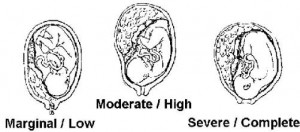a. Abruptio placentae is hemorrhage resulting from the detachment of the placenta.
Hypertension may cause this. It may occur any time during pregnancy. If the placenta becomes detached prior to the 20th week of gestation it is called a spontaneous abortion.
b. Abruptio placentae may be classified in three types of separation (see 0figure 1-6).
(1) Marginal/low separation. This occurs when the separation is low and is not complete; vaginal hemorrhage is evident.
(2) Moderate/high separation. This occurs when the separation is high in the uterine segment, causing the fundus of the uterus to rise. The fetus is in grave danger because of lack of oxygen. External hemorrhage will probably not be present here, whereas the amniotic fluid will be a port-wine color.
(3) Severe/complete separation. This occurs when the fetus head is present in the cervical os that prevents external hemorrhage. The fetus is in grave danger, and an immediate cesarean section will probably be needed in order to save the baby’s and mother’s lives.

c. Nursing implications are listed below.
(1) Record amount and character of vaginal bleeding.
(2) Maintain thorough peri-care to keep the mother feeling clean.
(3) Monitor the fetal heart tones per order. Deceleration indicates diminishing placental function.
(4) Monitor the mother’s vital signs per OB practitioner’s or physician’s orders. Death occurs from hypovolemic shock.
(5) Monitor IV fluids per order. IV fluids will be administered to replace fluid volume.
